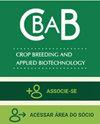机器学习的技术细微差别:植物育种中基因组预测监督方法的实施和验证
IF 1.1
4区 农林科学
Q2 Agricultural and Biological Sciences
引用次数: 3
摘要
摘要植物育种的决策过程是由数据驱动的。机器学习框架具有强大的工具,可以从数据中提取有用的信息。然而,人们仍然缺乏对这些方法的基本算法、它们的优势和陷阱的了解。机器学习有两个主要分支:有监督学习和无监督学习。在植物育种中,监督学习用于基因组预测,其中表型性状被建模为分子标记的函数。基因组预测的关键监督学习算法是线性方法、核方法、神经网络和树集合。这份手稿深入了解了这些算法的实现,以及如何使用交叉验证来比较方法。基因组预测的例子来自植物育种。本文章由计算机程序翻译,如有差异,请以英文原文为准。
Technical nuances of machine learning: implementation and validation of supervised methods for genomic prediction in plant breeding
Abstract The decision-making process in plant breeding is driven by data. The machine learning framework has powerful tools that can extract useful information from data. However, there is still a lack of understanding about the underlying algorithms of these methods, their strengths, and pitfalls. Machine learning has two main branches: supervised and unsupervised learning. In plant breeding, supervised learning is used for genomic prediction, where phenotypic traits are modeled as a function of molecular markers. The key supervised learning algorithms for genomic prediction are linear methods, kernel methods, neural networks, and tree ensembles. This manuscript provides an insight into the implementation of these algorithms and how cross-validations can be used to compare methods. Examples for genomic prediction come from plant breeding.
求助全文
通过发布文献求助,成功后即可免费获取论文全文。
去求助
来源期刊
CiteScore
2.40
自引率
13.30%
发文量
25
审稿时长
6-12 weeks
期刊介绍:
The CBAB – CROP BREEDING AND APPLIED BIOTECHNOLOGY (ISSN 1984-7033) – is the official quarterly journal of the Brazilian Society of Plant Breeding, abbreviated CROP BREED APPL BIOTECHNOL.
It publishes original scientific articles, which contribute to the scientific and technological development of plant breeding and agriculture. Articles should be to do with basic and applied research on improvement of perennial and annual plants, within the fields of genetics, conservation of germplasm, biotechnology, genomics, cytogenetics, experimental statistics, seeds, food quality, biotic and abiotic stress, and correlated areas. The article must be unpublished. Simultaneous submitting to another periodical is ruled out. Authors are held solely responsible for the opinions and ideas expressed, which do not necessarily reflect the view of the Editorial board. However, the Editorial board reserves the right to suggest or ask for any modifications required. The journal adopts the Ithenticate software for identification of plagiarism. Complete or partial reproduction of articles is permitted, provided the source is cited. All content of the journal, except where identified, is licensed under a Creative Commons attribution-type BY. All articles are published free of charge. This is an open access journal.

 求助内容:
求助内容: 应助结果提醒方式:
应助结果提醒方式:


